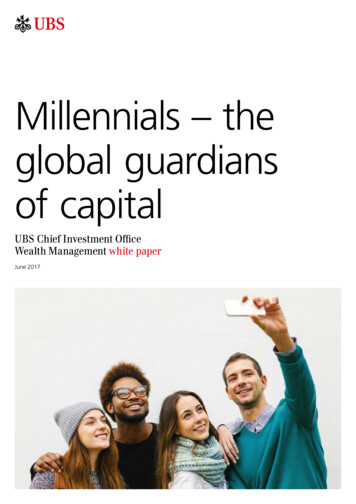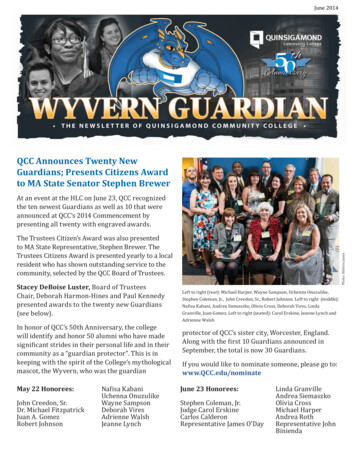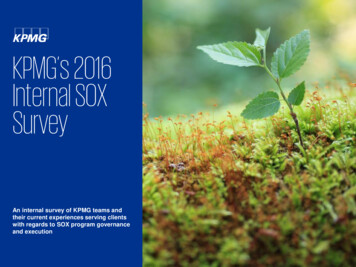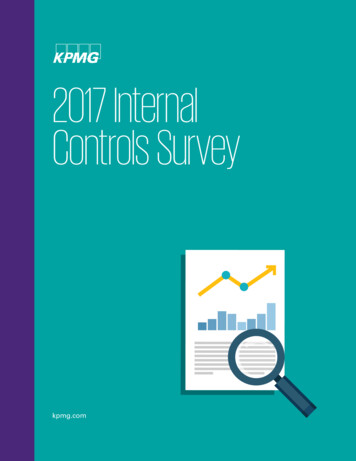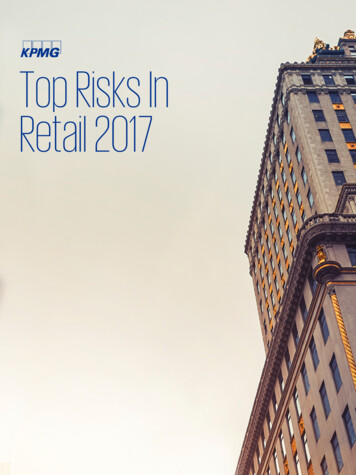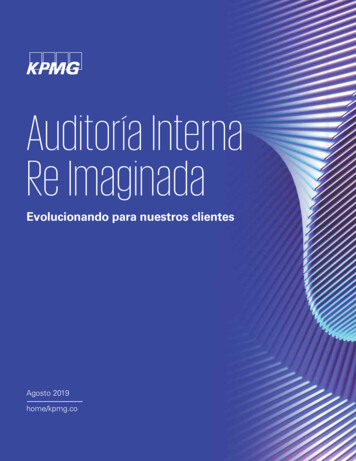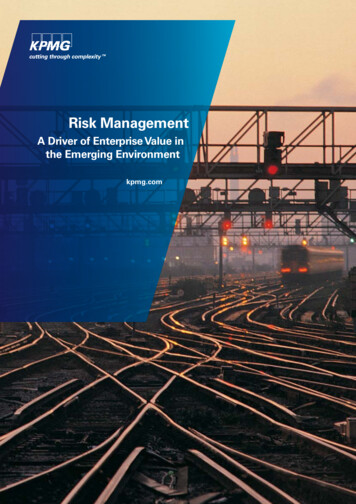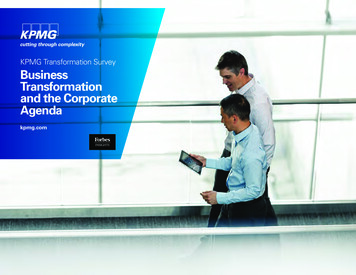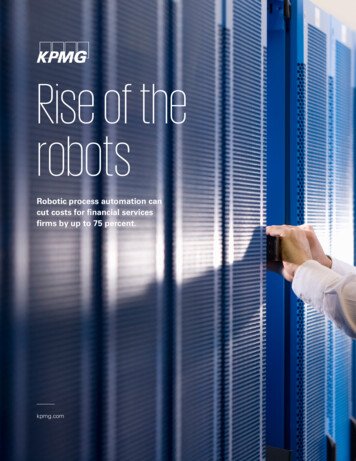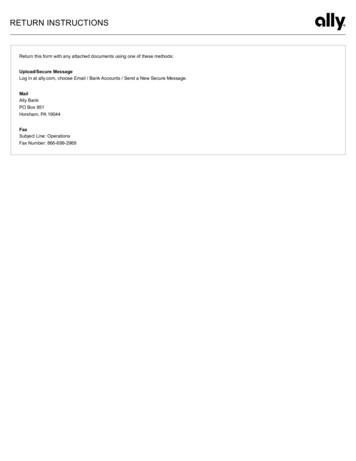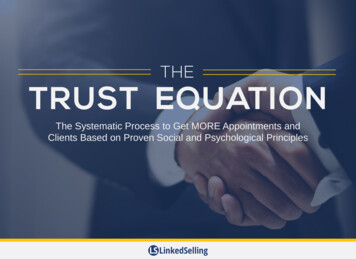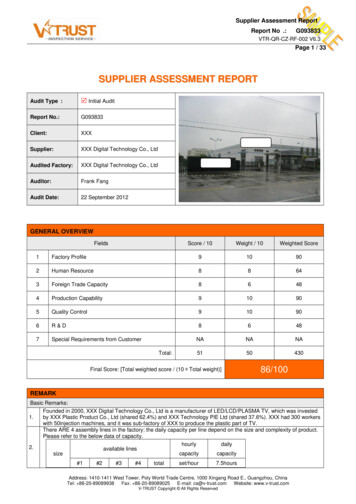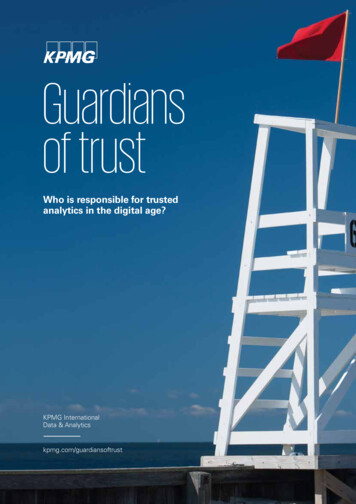
Transcription
Guardiansof trustWho is responsible for trustedanalytics in the digital age?KPMG InternationalData & Analyticskpmg.com/guardiansoftrust
Contents
Foreword2Summary4Trust in an age of digital transformation6The four anchors of trust10The trust gap: A lack of executive confidence in analytics12Insight — Machines misbehaving: New risks17Who is to blame?18Governance: Taking responsibility for trusted analytics22Interview — Microsoft: Designing a principles-based approach27Building the governance of AI into the core business28Interview — Amsterdam ArenA: Building an ecosystem of trust31Eight areas of essential controls for trusted data and analytics32In summary34Methodology36About Intelligent Automation and Data & Analytics at KPMG38Contributors39Country contacts40Acknowledgements40Additional references41
ForewordData breaches. Machine-based decisions. The rise of the robots.Amid fears and uncertainties in the digital age, the value of trust in a business cannot be overstated.Today, that trust relates not only to a company’s brand, products, services and people — but also to thedata and analytics (D&A) that are powering its technology.However, KPMG International research shows that companies are struggling to build this trust.In the recent Guardians of trust study, KPMG International commissioned Forrester Consulting to surveyalmost 2,200 global information technology (IT) and business decision makers involved in strategy fordata initiatives. The survey found that just 35 percent of them have a high level of trust in their ownorganization’s analytics.At a time when machines are working in parallel with people, this study points to a clear need forproactive governance of analytics in order to build trust.But who should be responsible for trusted analytics? And what does good governance look like? Asorganizations undergo digital transformation, with artificial intelligence (AI) sweeping through almost everyindustry, is someone taking responsibility for the quality, effectiveness, integrity and resilience of D&A?In the following report, we identify some emerging principles as well as some worrying opinions. Thereport summarizes the research findings, discussions with industry leaders who are making strides inbuilding trust, and the recommendations and observations on the governance of analytics.On behalf of KPMG International, I thank the senior executives who participated in the research andinterviews. Your candor, transparency and ideas have been invaluable in helping lead the way towardsgreater trust between people and machines.To discuss the issues raised in this report or to join us in the effort to bridge the trust gap, please contactyour local KPMG office or any of the authors listed at the back of this report.Dr. Thomas ErwinGlobal Head of KPMG LighthouseCenter of Excellence for Data& Analytics and IntelligentAutomationPartner, KPMG in Germany2 Guardians of trust
At a time when machines areworking in parallel with people,this study points to a clear needfor proactive governance ofanalytics in order to build trust.Guardians of trust 3
SummaryA trusted organization has traditionally been anchored by the behaviors and decisions of trusted people. As people giveway to machines, a trusted organization (and a trusted platform) also requires trusted data and analytics.KPMG International’s Guardians of trust report looks closely at the intimate relationship between trust and digital transformation within an organization — who is responsible for ensuring trusted analytics and what good governance can look likein a digital world.Trust in analytics is lacking*Trust in an age of digital transformation*Trust is becoming a defining factor of an organization’ssuccess or failure. Underpinning a company’s license tooperate effectively, trust reduces uncertainty and buildsresilience as well as:35%Onlyofrespondents say theyhave a high level oftrust in their ownorganization’s use ofdifferent types ofanalyticsinfluences reputationdrives customersatisfaction and loyalty25%andadmit that theyeither have limitedtrust or active distrust.inspires employeesExecutives andcustomers are waryof technologyRapid, uncertain techdisruption can lead to unstablelevels of internal and publicconfidence.The trust gap grows: C-suite executivesquestion the trustworthiness of data,analytics and intelligent automation*Few decision makers trust the way their organizationuses different types of analytics. But the trust gap isnot reducing with experience or time.4 Guardians of trustenables globalmarkets to functionTrust in adigital worldThe need for trust is expandingfrom trust in brands, organizationsand their employees to alsoinclude trust in machines,algorithms and analytics.92%areworried about theimpact on reputation
Understanding that trust in analytics isfounded on four key anchorsLevels of trust vary by geography*The trust gap is not the same in every country anddecision makers may need to adjust their approachdepending on the market they are in.EffectivenessQuality65%21%high levels of trustin India vs USTrustSpreading the blame*IntegrityResilienceEveryone should share some level of responsibility andaccountability for faulty or untrustworthy analytics.62%say that the blame for anautonomous vehicle accident lieswith the organization thatdeveloped the software.Trusted analytics is not a vague concept ortheory. At its core are rigorous strategiesand processes that aim to maximize trust.Who holds organizational responsibility?*Like human, like machineThe governance of machines should not be fundamentallydifferent from the governance of humans.It is not clear who withinthe organization has primaryresponsibility for ensuringthe trustworthiness andaccuracy of advancedanalytics and models.A larger percentage says itrests with the technologyfunction.?Key takeawaysCreating the foundationThere are eight areas that form the basis for emergingstandards, enablers and controls for trusted analytics.GovernanceProcessesRegulationDataPeople &cultureTechnologyStrategicalignmentAlliances andsupplier networksIf you can’tmeasure it,you can’tmanage itPrioritizerisksCreatetrust-impactpersonasCreate abuddysystemStay legalChecklistmanifestofor data andanalyticsDon’t letthe boardoff thehookBe flexiblewith horsesfor coursesCreate ameshgovernanceframework* Source: A commissioned study conducted by Forrester Consulting on behalf of KPMG International, July 2017Guardians of trust 5
Trust in an age ofdigital transformationTrust is a defining factor in an organization’s success or failure. Indeed, trustunderpins reputation, customer satisfaction, loyalty and other intangible assets,which now represent nearly 85 percent of the total value of companies in theS&P 5001, compared with tangible assets such as bricks and mortar. Trust alsocan inspire employees, enables global markets to function, reduces uncertaintyand builds resilience.It is no wonder that in the KPMG International Disrupt andgrow 2017 Global CEO Outlook survey, 61 percent ofnearly 1,300 chief executives said that building trust amongcustomers and other external stakeholders is a ‘top three’priority for their organization. Almost three-quarters said theirorganization is now placing a greater importance on trust,values and culture in order to sustain their long-term future.Organizations are also making unprecedented investmentsin new technologies. KPMG professionals are seeing massexperimentation and uptake in industries from banking andinsurance to telecommunications, healthcare, manufacturingFigure 1Trust influences corporate reputationsand drives customer satisfactionBuilding greater trust among external stakeholdersand customers is among the top three priorities ofmy organization today.61%overallagreeSource: 2017 Global CEO Outlook, KPMG International6 Guardians of trustand travel. Disruptors are leveraging data, sophisticatedanalytics, robotics and, increasingly, artificial intelligence (AI)to create new value propositions and business models.The age of AI also offers new ways of protecting public trustas we shift from humans towards machines. In audit, forexample, cognitive systems can analyze millions of recordsand identify patterns to create more insights on a company’sprocesses, controls and reporting. Algorithms, meanwhile,can be designed to reduce human biases in decision making,and blockchain can offer greater data security and newdistributed trust models.The widespread use of AI willmake it imperative — andmore difficult — to ensuretrusted analytics.
Trust inspires employees, enablesglobal markets to function, reducesuncertainty and builds resilience.Guardians of trust 7
From hype to humble realityIn a high-speed, highly digitized world, trust that has takenyears to build can be destroyed almost instantly. Amid therise of machines, organizations require trust not only in theirbrands and people but also in their data and analytics. Gettingthis right is not something that any enterprise can claim tohave mastered.Not surprisingly, some of those who manage analytics andautomation are concerned about the risks. The Guardians oftrust survey questioned 2,190 global senior business decisionmakers involved in setting direction for data and analyticsfrom nine countries. Ninety-two percent admitted they areworried about the reputational damage that inappropriate useof analytics could cause for their organization.Figure 2The impact of analytics on corporate reputationHow concerned are you about the following consequence if your organization's data and analyticsmodels do not work as intended or are inappropriately used?92%are moderately or highlyconcerned about theimpact on corporatereputationBase: 2,190 global IT and business decision makers with involvement in setting strategy for data initiatives at their organizationsSource: A commissioned study conducted by Forrester Consulting on behalf of KPMG International, July 2017Against this backdrop, C-suite executives are starting toask difficult questions about the trustworthiness of data,analytics and intelligent automation.What types ofgovernanceframeworks andcontrols are requiredwhen the risk-takersare machines, nothumans?How can decisionmakers trust theinsights they arereceiving whenthey don’t own thesource data?How would weknow if somethinghas gone wrong,and how should wemanage that?8 Guardians of trustHow do weredesign processeswhen we don’tfully understandthe algorithms thatpower them?How do I know thatmy models andalgorithms are doingthe right thing?
A double-edged swordWhile the digital age creates opportunities, it also createsnew concerns that can undermine trust across industries andour society as a whole.For example, constant news of data breaches, data misuseand inaccuracies is eroding public trust. What’s more,technology-driven disruptions can fuel increased nationalismand protectionism as the media predicts job losses andredundancies due to automation. There also is concernthat the benefits of digital transformation will not be evenlydistributed, therefore worsening disparities between thehaves and the have-nots.The widespread use of AI will make it imperative — andmore difficult — to ensure trusted analytics. Indeed, asorganizations adopt more sophisticated analytics, machinelearning models and automated decisions, many regulatorsare exploring new controls on all organizations that collect,analyze and use customer and business data. It’s time to askhow complex algorithms will be governed to help ensure fairtreatment and accurate outcomes.And herein lies the challenge of the double-edged sword.Organizations must embrace new technology, whileensuring high, stable levels of trust in an uncertain, fastchanging digital age.It’s time to ask howcomplex algorithms will begoverned internally to helpensure fair treatment andaccurate outcomes.Guardians of trust 9
92%concerned about misuseof data and analytics onFigure 4corporatereputationareorHow strongaremoderatelyyour anchorsof highlytrust? A vieHow well doesyour organizationalign with besconcernedabout misusedata and analytics onFigure4 withofase: 2,190 global IT and business decisionmakersinvolvement in setting strategy for data inreputationHowstrong corporateare your onanchorstrust?A 2017viewource: A commissioned study conductedby ForresterConsultingbehalf ofofKPMG,JulyThe four anchors of trust10%How well does your organization align with bestQuality of data, tools andse: 2,190 global IT and business decision makers with involvement in setting strategy for data inQualityource: A commissioned study conducted by ForresterConsulting on behalf of KPMG, July 201710%D&A capabilitiesQuality of data, tools and mre 4 Breaking the cycle of mistrust in D&A, it was proposed that Qualityconcept or theory. At its coreare rigorous strategiesandAccuracyof modelsand pD&Acapabilitiestrust in analytics is founded on four key anchors: quality,processes that aim to maximizetrust. Some are well knownw strongare your anchors of trust? A viewfrom 2016.effectiveness, integrity and resilience. And over the pastbut challenging, such as improving data quality. Others areKPMGyourprofessionalshave used this frameworkto help bestrelativelynew and undefinedin thetrustanalyticsanchor?sphere, such aswellyear,doesorganizationalign withpracticein eachEffectivenessorganizations assess their key trust gaps.ethics and integrity.UtilitySo how can the four anchorsimprove oftrustmodelsin analytics? and procre 4Accuracy of models and prostrong are your anchors of trust? A view from 2016.well does your giespractice in each trust anchor?Quality of data,toolsD&A regulatory complianUtility of models and proceIn KPMG International’s 2016 report Building trust in analytics:As noted in that 2016 report, trusted analytics is not a vague10%Anchor 1: QualityQualityIntegrityAnchor 3: Integrity10%22%D&A capabilitiesD&Aintegrityprivacyethical uIn the context of trusted analytics,refers andto ethicalQuality of data, tools and andmethodologiesacceptable use, fromcompliancewith data privacyD&AregulatorycomplianceOrganizations need to ensure that both inputs and analyticsmodels are appropriate for the context in which the insightswill be used. In many cases, this starts with questions aboutthe quality of the underlying data. And as analytics becomemore sophisticated and machines start to do their ownlearning, quality also extends to the models and algorithms.Qualityctiveness16% 22%20%Resilience16%laws to less clear areas such as the ethics of profiling andpredicting behaviors. This anchor is a growing concernof consumers, and it is rapidly becoming a key focus forregulators and policy-makers, as they strive to assess the‘fairness’ of analytical approaches.Integrity1Accuracyof models and processesD&AcapabilitiesD&AprivacysecurityD&Aand ethical usUtility of models and processesAccuracy of models and processesD&A governanceD&A security20%Base: 2,165 data and analytics decision-makersctivenessSource:a Anchorcommissionedstudy conducted by ForresterAnchor 2: Effectiveness4: ResilienceD&A regulatory complianceResilienceUtility of models andprocessesD&AgovernanceNote:Thechart shows thepercentageof respondents wEffectiveness is about the extent to which models achieveResilience is about optimizing data sources and analyticsD&Aanchor.desired results, providing value to decision makers whorely trustmodelsfor the long term. Cyber security is a well knownIntegrityon the generated insights. When analytics are also think about the changingBase: 2,165 data butandanalyticsineffective, or are usedD&Ain an anddigitalinfrastructure. This kindprivacy and ethical usequickly erode.of resilience is particularlyimportantas dForrester CoD&A regulatory complianceself-learning and reliant on one another, using integratedNote: The chartshowsthepercentageof respondents whalgorithmsto acquireinputdata.D&A trust anchor.Integrity13%13%10 Guardians of trustD&A privacysecurityand ethical useD&A20%
Measuring the four anchors of trustof respondents struggled to achieve excellence across each ofthe anchors. Just one in 10 respondents said they excelled indeveloping and managing analytics, while only 13 percent saidthey excelled in privacy and ethical use. Fewer than one-fifththought they performed well in ensuring accuracy.In the 2016 survey, organizations were asked how theymeasured each of the trust anchors. We found that almost allorganizations needed to close several capability gaps.In fact, with the exception of regulatory compliance (whereorganizations tended to perform strongest), the vast majorityFigure 3How strong are your anchors of trust? A view from 2016How well does your organization align with best practice in each trust anchor?10%Quality of data, tools and methodologiesQuality22%D&A capabilities16%Accuracy of models and processesEffectivenessUtility of models and processes20%44%D&A regulatory compliance13%IntegrityD&A privacy and ethical useD&A securityResilienceD&A governance20%18%Base: 2,165 data and analytics decision makersSource: a commissioned study conducted by Forrester Consulting on behalf of KPMG International, July 2016Note: The chart shows the percentage of respondents who selected 'describes our approach exactly' for all of the capabilities explored under theD&A trust anchor.Guardians of trust 11
The trust gap:A lack of executiveconfidence inanalyticsGiven the power that it holds, trust in D&A should be a non-negotiable businesspriority. Yet the Guardians of trust survey suggests there is a growing trust gap.Businesses want the benefits that digital and automation can deliver, but they don’talways trust the underlying analytics that power those machines.In the survey, just 35 percent of respondents said they havea high level of trust in their own organization’s use of differenttypes of analytics. A quarter admitted that they either hadlimited trust or active distrust.This lack of trust does not seem to have shifted in the pastyear. In the 2016 KPMG Building trust in analytics survey,34 percent of respondents reported a high level of trust intheir operational analytics, and 38 percent professed hightrust in the analytics that drive their customer insights.Figure 4The trust gapTo what extent do you trust the way your organization uses different types of analytics?High level of trust35%Usually trusted,but somereservations40%Limited trust, withregular challenges,signs of uncertaintyActive distrust orreluctance to use19%6%Base: 2,190 global IT and business decision makers with involvement in setting strategy for data initiatives at their organizationsSource: A commissioned study conducted by Forrester Consulting on behalf of KPMG International, July 201712 Guardians of trust
Businesses want the benefitsthat digital and automation candeliver, but they don’t alwaystrust the underlying analytics thatpower those machines.Guardians of trust 13
Reasons for mistrustMost people already have an idea of what ‘trusted data andanalytics’ should mean in both their professional and theirpersonal lives. They want to know that the data and analyticsare correct, and they want to know when something is wrong.They also want data to be used in a way they understand, bypeople they trust, and for a purpose they believe is valuable.Some trust issues are straightforward. If managementhas experienced unreliable data or poor insights, they arelikely to lose trust in the system they are using. But astechnologies become more complex, the trust issues alsobecome more complex.“Executives and managers are being asked to make majordecisions based on the output of an algorithm that they didn’tcreate and don’t always fully understand,” noted Dr. ThomasErwin, Head of Global Lighthouse, KPMG International. “Asa decision maker, you
A trusted organization has traditionally been anchored by the behaviors and decisions of trusted people. As people give way to machines, a trusted organization (and a trusted platform) also requires
